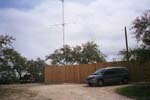
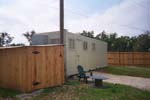
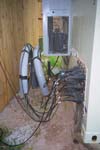
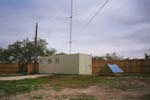
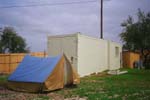
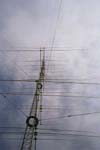
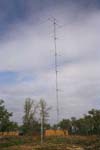
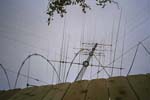
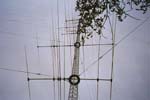
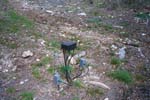
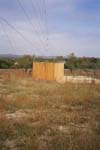
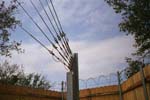
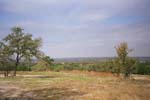
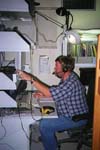
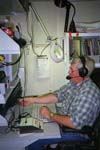
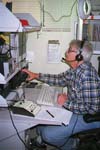
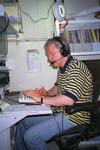
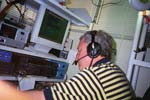
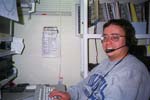
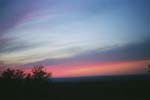
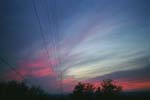
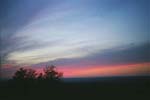
John N5CQ has built a world-class Amateur Radio DXing station in the hills west-southwest of Austin, TX. He invited some members of the Central Texas DX and Contest Club (CTDXCC) to come out and operate in the 1999 ARRL International DX Contest, phone, as a Multiple Operator, Single Transmitter (M/S) operation. I spent the entire weekend at the station, and got the opportunity to take some photos.
N5CQ tries to cover all the angles and all the bands on a single tower with a stack of six Force 12 tribanders on Rohn 55G rotated with RTS components. Three pairs are fed with 3 "Mini Stack Match" transformers and a Stack Match control unit on 20, 15 and 10 meters, allowing selection of any pair, any two pairs, or all three pairs. Three of the antennas are C3's (at 35, 95, and 125 feet) and three are C4XL's (at 65, 125, and 195 feet). The three C4XL's also incorporate interlaced 2 element "shorty forty" sections which are fed with separate feed lines and another Stack Match. Also on the tower are a WARC-7 beam for 30, 17, and 12 meters at about 105 feet, a 2 element linear loaded 80M Force 12 Magnum 280C at 185 feet, and a 160M sloper.
These photos are copyright © 1999-2003 Kenneth E. Harker. All rights reserved.
 |
The view of N5CQ's station as you come up the driveway. There is an eight foot high fence all around the station building, topped with barbed wire and concertina razor wire. This keeps the deer out. |
 |
The station at N5CQ is a converted container ship shipping container. It has had windows cut into it, and the interior is finished with tile, drywall, electrical wiring, and indoor plumbing. |
 |
All the feedlines enter the shack at a single point. Inside the rubber boots are PolyPhaser lightning/NEMP suppressors. You can also see the heavy-duty copper grounding straps. The feedlines are routed through the PVC conduit underground to the tower base. Above the feedlines is the air conditioning unit for the shack. |
 |
The blue tent to the right of the station is where I slept - I always have trouble sleeping while I can hear people talking. Even early March in south Texas is plenty warm for camping out. On the telephone pole next to the station is a three element 144MHz antenna for the local PacketCluster (which is about 80 kilometers away,) and a low 40M wire dipole you can't really see. |
 |
Another view of my tent. I borrowed it, and a U.S. Navy sleeping robe, from Robin KC5NUU. The tent was large enough for three people. |
 |
John has a single tower. It is 195' tall, constructed out of Rohn RG-55G, and the entire tower rotates. Here, we can see the guy rings pretty clearly. Each antenna is simply bolted to the side of the tower. There is a heavy duty Hygain HDR300A rotor mechanism at the base of the tower. This is an RTS components rotating tower design. |
 |
This is another view of the tower from further back. From bottom up: Force 12 C-3, Force-12 C-4XL, Force 12 C-3, Force 12 WARC-7, Force 12 C-4XL, Force 12 C-3, Force 12 Magnum 280C, Force 12 C-4XL. You can't really see it, but there's a full-size 160 meter inverted V wire antenna hanging sideways off one side of the tower (like a sloper dipole, but with the lower wire pulled back to the base of the tower.) |
 |
This is a view looking up the tower from near the bottom, outside the fence that goes around the tower base. |
 |
Another view of the tower near the base. |
 |
Several hundred feet from the station, this is the feedpoint for the two beverage antennas. The one on the left is aimed at Japan, and the one on the right is aimed at Europe. The boxes here contain the matching termination and the remote coax switch. |
 |
Two of the tower guy points are outside the main station compound, and each has its own fence to keep the deer out. In the background, you see the horizon to Europe. |
 |
This a close-up of the one guy point that is inside the station compound. |
 |
This is the horizon, as seen from ground level during the day, to the north-west, looking on the central Texas hill country. |
 |
John Langdon N5CQ, the man himself. John had some fantastic rate on 20M into Europe around 2AM local time on Sunday morning. His left hand is on the tower rotor control head. |
 |
Phil Duff NA4M. Phil handled both of the morning openings to Europe. In the afternoons, he operated at the N5TW M/S effort. The yellow box in the foreground is a W2IHY Audio Memory Keyer, which also has an audio equalizer and noise gate. |
 |
Tom DeWitt W5TD. Tom operated Sunday afternoon, mainly finding new multipliers. Tom had also operated at the M/S effort at the station of N5TW, another CTDXCC member, in Georgetown, TX, on Saturday (about 90 kilometers NNE of N5CQ.) The radio is a Yaesu FT-1000MP. |
 |
Jim George N3BB showed up for a few hours Sunday afternoon. Just barely in frame at the top left is a black corner of the Alpha 87A HF amplifier. John uses the computer-controllable interface on the Yaesu FT-1000MP to tie the logging program, main antenna switch, and linear amplifier together for hands-free, nearly instantaneous band switching. |
 |
Another view of Jim George N3BB. To the right of the radio are two WX0B StackMatch control boxes, one for the 10-15-20 tribander stack, and one for the 40M elements on the Force-12 C-4XLs. Above it is the remote coax switch for the beverages, and an SWR/power meter. While not really visible from this angle, the computer is running TRLog 6.36. |
 |
Ken Harker KM5FA. This photo was actually taken half an hour after the contest, when I hadn't shaved in three days. I had a good run to JA on 10M Saturday night, peaking at 126 QSOs in the 0000-0100 hour. N5CQ took this photo. |
 |
A view of the sunset over the central Texas hill country on Friday night, about an hour after the start of the contest. |
 |
Another scene of the sunset, with one of the tower's guy anchor points in the foreground. |
 |
These three sunset photos were taken from the roof of the station. |
|
Last Updated 26 June 2020 wm5r@wm5r.org |